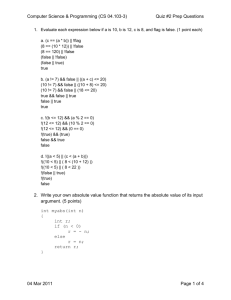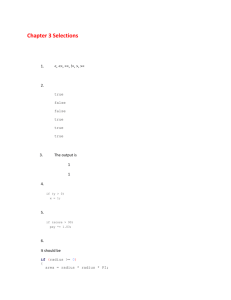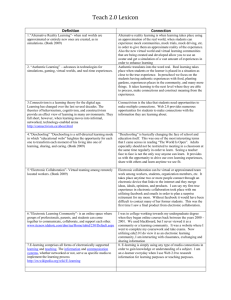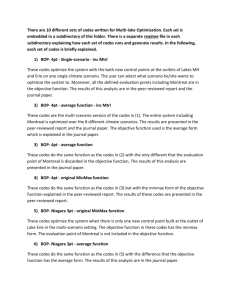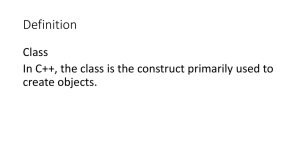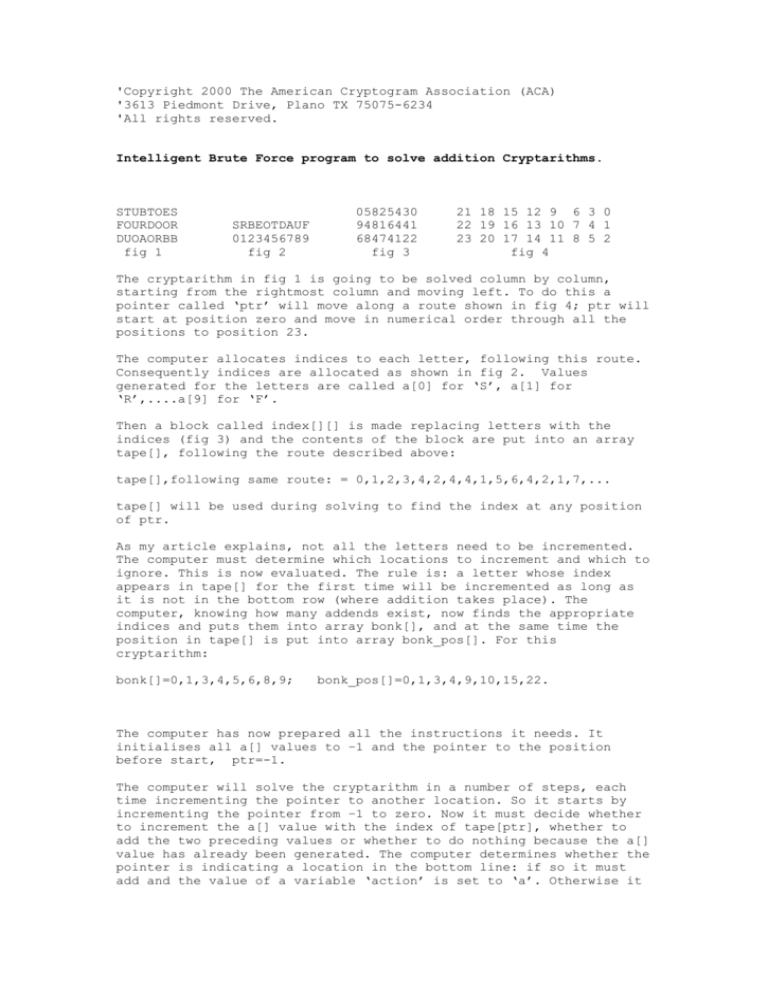
'Copyright 2000 The American Cryptogram Association (ACA)
'3613 Piedmont Drive, Plano TX 75075-6234
'All rights reserved.
Intelligent Brute Force program to solve addition Cryptarithms.
STUBTOES
FOURDOOR
DUOAORBB
fig 1
SRBEOTDAUF
0123456789
fig 2
05825430
94816441
68474122
fig 3
21 18 15 12 9 6 3 0
22 19 16 13 10 7 4 1
23 20 17 14 11 8 5 2
fig 4
The cryptarithm in fig 1 is going to be solved column by column,
starting from the rightmost column and moving left. To do this a
pointer called ‘ptr’ will move along a route shown in fig 4; ptr will
start at position zero and move in numerical order through all the
positions to position 23.
The computer allocates indices to each letter, following this route.
Consequently indices are allocated as shown in fig 2. Values
generated for the letters are called a[0] for ‘S’, a[1] for
‘R’,....a[9] for ‘F’.
Then a block called index[][] is made replacing letters with the
indices (fig 3) and the contents of the block are put into an array
tape[], following the route described above:
tape[],following same route: = 0,1,2,3,4,2,4,4,1,5,6,4,2,1,7,...
tape[] will be used during solving to find the index at any position
of ptr.
As my article explains, not all the letters need to be incremented.
The computer must determine which locations to increment and which to
ignore. This is now evaluated. The rule is: a letter whose index
appears in tape[] for the first time will be incremented as long as
it is not in the bottom row (where addition takes place). The
computer, knowing how many addends exist, now finds the appropriate
indices and puts them into array bonk[], and at the same time the
position in tape[] is put into array bonk_pos[]. For this
cryptarithm:
bonk[]=0,1,3,4,5,6,8,9;
bonk_pos[]=0,1,3,4,9,10,15,22.
The computer has now prepared all the instructions it needs. It
initialises all a[] values to –1 and the pointer to the position
before start, ptr=-1.
The computer will solve the cryptarithm in a number of steps, each
time incrementing the pointer to another location. So it starts by
incrementing the pointer from –1 to zero. Now it must decide whether
to increment the a[] value with the index of tape[ptr], whether to
add the two preceding values or whether to do nothing because the a[]
value has already been generated. The computer determines whether the
pointer is indicating a location in the bottom line: if so it must
add and the value of a variable ‘action’ is set to ‘a’. Otherwise it
checks whether the location pointed to is in array bonk_pos[]: if so
action is set to ‘i’ to indicate incrementing must be done.
The program now initiates appropriate action – either add or
increment – to complete the cycle. It then commences a new cycle by
incrementing the pointer to the next location
The ‘i’ procedure. The present value of the current index is copied
into ‘x’ by the command:
x=a[tape[ptr]].
x is then incremented until it reaches a value which is different to
any other a[] that precedes it. So for example if the ptr=9, then
from tape[] the index of the letter is 5, so x is made equal to a[5]
and is incremented. Then x is compared with a[0] to a[4] and if it is
the same as any of these values, then x will continue to be
incremented until it becomes unique.
If in this process ‘x’ should become equal to base (ie 10 for this
example) it is reset to –1, and the computer backs up to the location
of the last incrementation. This location is the location before 9 in
array bonk_pos[], which is 4. The pointer is reset to 4. The index at
location 4 is tape[4] which also happens to be 4. Now the computer
repeats the incrementing routine, putting x=a[4], and backing-up
again if x becomes equal to base. This procedure continues until a
value of ‘x’ is eventually found that is unique -- the incrementing
procedure is complete.
The ‘a’ procedure. The computer first adds up the two preceding a[]
values, whose indices are found as the two preceding values in
tape[], together with any carry[] from the previous column. If the
sum is 10 or more, then it notes a digit value of (sum-10) and a
carry forward of 1 for the addition. (If there are three addends then
of course the three preceding values are added together).
Now come two crucial checks. The digit must not be the same as any
other previous value of a[] unless that previous a[] has the same
index as the present location – in other words the same value must
have the same letter.
Moreover, if the index of the present location is the same as the
index of an a[] evaluated before the current location, then digit
must have the same value as that a[] – in other words the same letter
must have the same value.
If these checks are passed then the value of digit is put into a[]
with the present index – ie into a[tape[ptr]] -- and the value of ‘y’
is put into carry[] indexed to the present column. If one of the two
checks fails, the last incrementation must be repeated, so the
computer must go back to the last location of incrementation by
resetting the pointer to that location as explained above – and then
backing up one further position ready for incrementing in the next
cycle.
The add procedure is now completed.
When the pointer
satisfactory add
The program then
last incremented
reaches the final location and completes a
there, a solution has been found. This is displayed.
looks for more solutions by going back to the value
, and incrementing again.
Eventually a[0] will reach a value equal to the base, indicating that
all possible perms have been tried. The computer then stops and
declares it has finished.
For those who would like to see how a program might implement the
above plan I append my C++ program -- with no claims for its
erudition.
C++ program.
#include
#include
#include
#include
#include
#include
<iostream>
<conio.h>
<stdio.h>
<stdlib.h>
<fstream.h>
<string.h>
char key[50],w[30][30],letters[50],block[10][20],action;
int j,k,m,nr,p,r,t,x,y;
int carry[50],value[50],base,noi,ptr,flag,bad,sum,noa;
int len,now,len_w[30];
int ni,nos,target,repeat;
int a[30] = {-1,-1,-1,-1,-1,-1,-1,-1,-1,-1,-1,-1,-1,-1,-1,-1};
int noc,nor,row,col,good;
int index[20][30];
int bonk[50],bonk_nr,len_bonk;
int bonk_pos[50],tape[50];
int digit,bonk_index,a_index,c[20];
void initialise(void);
void display(void);
main()
{
strcpy(w[0],"STUBTOES");
strcpy(w[1],"FOURDOOR");
strcpy(w[2],"DUOAORBB");
base=10;
initialise();
//measure parameters and set up instructions
do{
do
{
ptr++;
action=' ';
if( (ptr+1)%now==0) {action='a'; col=(ptr+1)/now; } // bottom line so add
else
// not bottom line so increment if pointer is in bonk_pos[]
{
good=0;
for(m=0;m<len_bonk;m++) if(ptr==bonk_pos[m]) {good=1;break;}
if(good==1) action='i';
}
switch(action)
{
case 'i':
{
do{
a_index=tape[ptr];
x=a[tape[ptr]];
//..increment x and repeat as long as x is not unique..
do{
x++;
flag=0;
for(m=0;m<a_index;m++) if(a[m]==x) {flag=1;break;}
}while(flag>0);
//..if x too large put a[]=-1 and repeat to increment last incremented..
if(x>base-1)
{
repeat=1;
a[tape[ptr]]=-1;
ptr=bonk_pos[bonk_index-1];
bonk_index=bonk_index-1;
// ptr goes back to last incremented
site
// bonk_index goes back to same place
}
else {repeat=0; a[tape[ptr]]=x;}
}while(repeat>0);
break;
}
case 'a':
{
sum=0;
for(m=1;m<noa+1;m++)
sum=sum+a[tape[ptr-m]];
sum=sum+carry[col-1];
digit=sum%base; y=sum/base;
bad=0;
// y is carry
// bad if digit same as value a[] but index a[] is different to present site
for(m=0;m<ptr;m++)
if(digit==a[tape[m]] && tape[m]!=tape[ptr] && tape[m]!=20) {bad=1;break;}
//bad if indices of a[] & present site are same but value a[] different to digit
if(bad==0)
{
target = tape[ptr];
for(m=0;m<ptr;m++)
if(tape[m]==target && digit != a[tape[m]]) bad=1;
}
if(bad==1)
{
//..find position of last incrementing..
flag=0;
for(m=ptr-1;m>-1;m--)
{
for(p=0;p<len_bonk;p++)
if(m==bonk_pos[p]) {bonk_index=p;flag=1;break;}
if(flag==1) break;
}
ptr=bonk_pos[bonk_index];
ptr--;
}
else // all is well, addition is successful
{
a[tape[ptr]]=digit;
carry[col]=y;
}
}
} // end switch
if(a[0]<0) break;
// have tried all possible perms so finish
} while(ptr<noc*now);
if(a[0]>-1) // a solution has been found so display results
{
nr++;
cout<<"Solution #"<<nr<<endl<<" ";;
for(m=0;m<base;m++) cout<<letters[m]<<" ";cout<<endl;
for(m=0;m<base;m++) if(a[m]<10) cout<<" "<<a[m]<<" ";
else
cout<<a[m]<<" ";
cout<<endl;
cout<<"Letters arranged 0 to "<<base-1<<" = ";
for(p=0;p<base;p++)
for(m=0;m<base;m++)
if(a[m]==p) cout<<letters[m];
cout<<endl;
cout<<"Nr of steps = "<<nos<<endl;
cout<<endl;
}
}while(a[0]>0);
cout<<endl<<"end";
getch();
return 0;
}
//-----------------------------end of main procedure---------------------------void initialise(void)
{
int delta;
a[20]=0;
for(j=0;j<10;j++) if(strlen(w[j])==0) break;
now=j; noa=j-1; //Nr of words and Nr of addends
for(j=0;j<now;j++) len_w[j]=strlen(w[j]);
noc=len_w[now-1]; nor=now; //Nr of columns and Nr of rows
//...make block of letters....
for(row=0;row<now;row++)
{
delta=noc-len_w[row];
if(delta>0)
for(j=0;j<delta;j++) block[row][j]=' ';
for(j=0;j<len_w[row];j++) block[row][delta+j]=w[row][j];
}
//..make block of index numbers and make array letters[]....
t=-1;
for(col=noc-1;col>-1;col--)
{
for(row=0;row<nor;row++)
{
if(block[row][col]==' ') {index[row][col]=20;continue;}
flag=0;
for(m=0;m<strlen(letters);m++)
if(block[row][col]==letters[m])
{x=m;flag=1;break;}
if(flag==0) {t++; x=t; letters[t]=block[row][col];}
index[row][col]=x;
}
}
//..make tape[] array of indices
t=-1;
for(col=noc-1;col>-1;col--)
for(row=0;row<now;row++)
{t++; tape[t]=index[row][col];}
//..make array bonk[] of indices to be incremented
//..and array bonk_pos[] of their locations...
t=-1; len_bonk=0;
for(j=0;j<now*noc;j=j+now)
for(k=0;k<now-1;k++)
{
flag=0;
for(m=0;m<len_bonk;m++)
if(tape[j+k]==bonk[m]) {flag=1;break;}
for(m=0;m<j+k;m++)
if(tape[j+k]==tape[m]) {flag=1;break;}
if(flag==0 && tape[j+k]!=20)
{
bonk[len_bonk]=tape[j+k];
bonk_pos[len_bonk]=j+k;
len_bonk++;
}
}
display();
}
//------------------------end of initialise procedure--------------------void display(void)
{
for(row=0;row<now;row++)
{for(col=0;col<noc;col++) cout<<block[row][col]; cout<<endl; }
cout<<" index[row][col] : "<<endl;
for(row=0;row<now;row++)
{for(col=0;col<noc;col++)
if(index[row][col]<10) cout<<" "<<index[row][col]<<" ";
else cout<<index[row][col]<<" ";
cout<<endl; }
cout<<"Letters: ";for(j=0;j<base;j++) cout<<letters[j]<<" "; cout<<endl;
cout<<"Indices: ";for(j=0;j<base;j++) if(j<10) cout<<" "<<j<<" ";
else cout<<j<<" ";
cout<<endl<<"Nr of cols= "<<noc<<"
Nr of rows= "<<now<<endl;
cout<<"tape:
"; for(j=0;j<now*noc;j++) cout<<tape[j]<<" ";cout<<endl;
// cout<<"action: ";for(j=0;j<now*noc;j++) cout<<action[j]<<" ";cout<<endl;
cout<<"bonk:
"; for(m=0;m<len_bonk;m++) cout<<bonk[m]<<" "; cout<<endl;
cout<<"bonk_pos: "; for (m=0;m<len_bonk;m++) cout<<bonk_pos[m]<<" "; cout<<endl;
cout<<"initialisation
}
done"<<endl<<endl;

